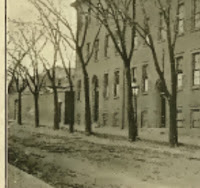About this time was purchased a lot of land from a certain John Hennessy for $4,000, and the buildings having been moved in the Spring of 1880, and the ground cleared, a brick wall was built on Adams street extending 123 ft in length.
This is the first mention of the brick wall that surrounded
the school, academy, convent, chapel and grounds of the Sisters. One of the next entries in the Annals tells
that the Sisters had to sell off their cows and poultry and to close the gardens
which grew some of their food. The Rule
of the SNDs was changing. The Sisters
who once freely mixed with parishioners and often visited homes as nurses were
now to be semi-cloistered. The wall was
extended along the Suffolk Street side as well and the vegetable gardens were
transformed into formal gardens. The
greatest section of the wall was brick with a granite capstone. Looking at the eastern wall of St Patrick
Church a large outline of a doorway exists today. Though many recall it as a way to get from
the school to the church, originally it was where the Sisters would sit to
observe the Mass. The Order mandated
that the Sisters were no longer to assist at Mass sitting with the congregation
and to remain within the cloister. The
Sister who wrote the annals during this period put in that this was a sad time
for both the Sisters and parishioners.
The inclusion of such personal feelings was highly unusual and shows the
close ties the two groups must have enjoyed.
The convent wall was a source of intrigue for many neighborhood children
who would devise means on finding their way in and mention is made of neighbors
hearing the nuns chanting the Divine Office or the Tantum Ergo on Sunday
afternoons. Even William Cardinal
O’Connell mentions that he would make his way over to the Acre and scale the
wall with his friends to see the Sisters walking in the flower gardens and
grotto.
When the old school was demolished and the new school built
in 1958 most of the wall was taken down with it.
The Sisters moved to the Academy grounds at Tyngsboro and made the daily
trek by car. The wall no longer served
its purpose. A small section remained in
front of the current school along with several granite capstones strewn along
the fence near the housing. By the 1980s
the wall was becoming a hazard. Bricks
were falling out. The mortar was
deteriorating making the wall a potential hazard. I was there the day they took it down,
pleading that maybe a small section could be retained. As the workmen left I stole a single brick,
the only relic to tell the story. If
walls could speak……..
